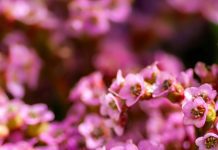
Peace Lilies are native to the South American rain forests where they grow on the forest floor. The soil is rich in peat moss and humus, providing the plant with decayed organic material, bark, and aeration for the roots.
The rain forests are warm and humid, and being on the forest floor under the cover of the tall trees provides shade from the hot sun; this is the perfect growing environment for Spathiphyllum.
So, what is the perfect growing environment for a Peace Lily in your home?
Simulate the natural environment of the forest floor where the sunlight is indirect and dappled; a north or western exposure is the best. Keep your lily about 6 – 8 feet away from the window; this allows for consistent light levels; maintain temperatures 65 – 80 degrees Fahrenheit and avoid cold drafts. Misting your lily often provides humidity and keeps the leaves clean and glossy allowing for better photosynthesis. Rich potting soil with humus or peat moss, such as an orchid type of soil will allow for drainage and the necessary aeration for the roots. Avoid potting mixtures that contain soil as they will be too heavy and may contain fungus or pests, and may also contain fertilizer, which the Peace Lily needs very little of.
Even when we provide all the necessary requirements for our lily, we may still see some symptoms of problems. The most common symptom is brown leaf tips. This could indicate that your Peace Lily has too much light or too much fertilizer.
A droopy Peace Lily is wilted, usually from a lack of water, but will recover quite quickly. Be sure to water your lily until the excess water runs out the bottom of the pot. A Peace Lily that droops often (more than once a week) may mean that it needs to be re-potted.









